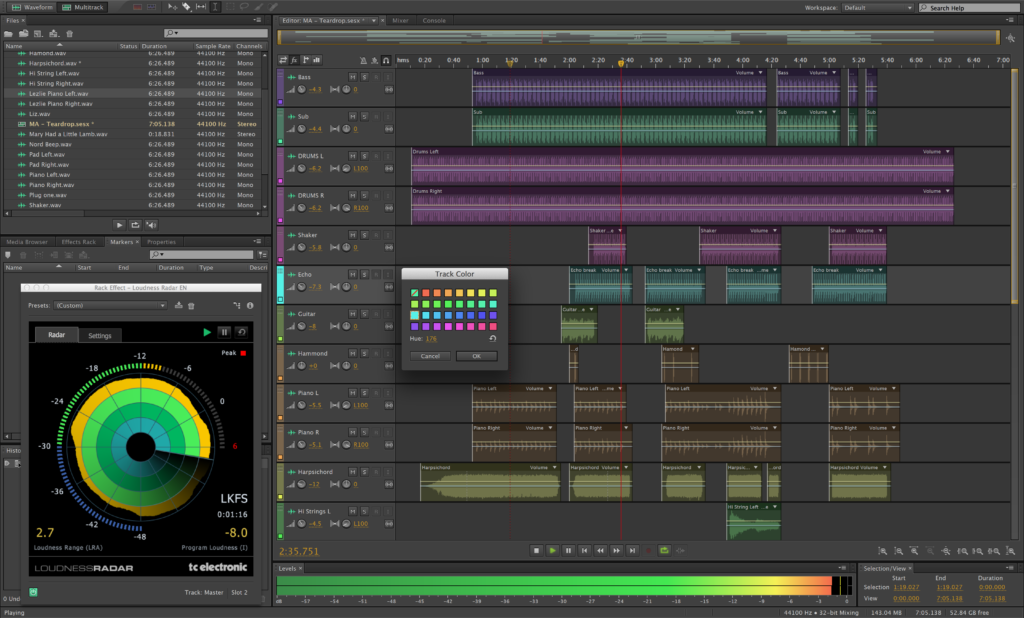Free Download Audition Project. Twitch Live Stream voice effects using Adobe Audition CC, OBS (or xsplit), and Virtual Audio Cable. Live Stream Voice Tutorial for Twitch w/ Adobe Audition CC + OBS (Free Download - God Voice).
- May 29, 2017 Unfortunately Audition can only record the audio sent to it by your audio interface or soundcard. So if your soundcard doesn't have a 'What You Hear' recording option then I'm afraid Audition won't be able to record any audio streamed from the Internet. The only option is to use third party software like Screen Recorder.
- Adobe Audition is one of the best audio editing now. It can record live from the microphone and also from streaming in internet or audio player. Now i wanna share here of how to record streaming audio using Adobe Audition. I use here Adobe Audition 3.0 and i think each versions can record audio streaming.
Step 1) Setting up Adobe Audition.
first create a new multitrack session in AA using the default settings
Step 2) Setting up your mic.
On the first track of your multitrack, click the drop down that says 'default stereo input' and select 'audio hardware'
Next, change your default output to Line 1 (this audio device was created when you installed VAC)
and change the latency to 50 (this number may vary for you, play around with it to find a setting that wont cause any audio stuttering)
Step 3) Setting up the audio pass-through.
back on the main window, on the first track, click the 'R' button in the upper right, followed by the 'I' button. this will let our audio pass to our Line 1 in realtime (there is in actuality some latency, but non to really be mention worthy)
Step 4) Setting up the noise reduction.
on the left, you will find an 'effects rack' tab, that should already be selected. on the first row click the right facing arrow, go down to noise reduction/restoration, and select adaptive noise reduction. a window will pop up after this. you can play with the sliders if you like, but the default setting works well. you can close that pop up window after.
Step 5) Setting up the mic in OBS.
Last step woo! open up OBS, go to the settings, then click on audio. under the 'microphone/auxiliary audio device dropdown you want to pick your Line 1 (virtual audio cable) device. that's it! your mic is now being filtered in realtime by AA
Disclaimer
Something to keep in mind while using this method of mic cleanup is that it DOES use some CPU. the CPU use on my system is negligible however, only ever peeking at 2%. this is with a Intel Ivy i5-3750k. Your results may vary
Adobe Audition Streaming App
The June 2015 release of Adobe Audition CC includes several features that enhance your productivity while working with audio, including the ability to stream video directly from Premiere Pro to Audition through Dynamic Link.
The new Dynamic Link video streaming feature lets you stream video without rendering when sending projects from Premiere Pro to Audition.
When you send Premiere Pro projects to Audition using the Dynamic Link video streaming video option, you can view video in its native resolution within Audition. Previously, Audition always rendered videos in native formats into DV files in 720x480 format at 30 fps, which resulted in a loss of native video attributes.
Adobe Audition Streaming Free
In a Project panel, select a sequence containing audio.
Select Edit > Edit In Adobe Audition and then select Sequence from the submenu.
Select Edit > Edit In Adobe Audition and then select Sequence from the submenu.
In the Edit In Adobe Audition dialog, under Video, choose Send Through Dynamic Link.
Select Open In Adobe Audition to open the selected clip in its native format in Audition.
Audition now lets you easily replace assets within an open project. Any edits made to the original clip are retained and applied to the new material so you can work uninterrupted even when an asset changes.
For example, you can use a song as a soundtrack, and then replace that file while retaining all the applied automation and effects, such as ducking or fades. You can replace assets without having to re-create the whole audio track from scratch.
Get the most out of your editing experience in Audition by using a full-screen dual-monitor workflow.
Display the contents of your video panel full-screen on a secondary monitor using HDMI, DVI, or VGA. This feature is especially useful for editing Foley and sound effects to video, recording ADR (Automatic Dialog Replacement) or voiceovers, and displaying your work as you edit.
Note:
This implementation does not support Mercury Transmit, so you are unable to use external video I/O with third-party Transmit plug-ins.
Audition lets you store periodic backups of your session file to prevent any loss due to power failure, crash, or file corruption.
In the Preferences dialog, choose Auto Save, and select Backup Multitrack Session Files Automatically. Then, choose a backup location that can be your Creative Cloud storage environment, the session folder, or any other location of your choice.
You can now manage projects with imported content more easily. Audition copies and relinks all imported media to the backed-up files stored within the Session folder.

This nifty feature makes sharing, collaboration, and archival easier and more reliable.
Note:
When copying imported files that contain a Dynamic Link to a Premiere Pro sequence, Audition does not copy the Premiere Pro assets to the Session folder. Only the audio files within the Audition timeline are copied.
Audition can import markers from any file containing XMP marker metadata including video files from Premiere Pro and Prelude. You can import markers into either an audio file (displayed in the Waveform editor) or a multitrack composition in Audition.
You can share these markers with third-party applications by exporting the markers to a CSV file using the Markers panel (Window > Markers). At any point, you can import the CSV markers file back into Audition.
You can use the imported markers as:
- Time-code markers for video content, or,
- Create and export sample-based markers for audio editing precision. For example, lighting designers for a theater show can use Audition to provide waveform-based markers or queues for their live shows.
Audition lets you set custom levels for Yellow (Caution) and Red (Warning) indicators in the Level Meters panel (Window > Level Meters).
You can conform to station regulations or personal preferences by selecting custom values for level meter crossover points. In the Preferences dialog, select Playback, and specify the Yellow and Red levels.
You can now schedule recordings in advance and Audition captures them automatically, or starts recording immediately for a specified duration.
Audition now provides improved support for USB microphones. You have noticeably lesser issues when switching between applications that share an audio device. In addition, when recording using different audio devices, you no longer see 'sample rate mismatch' errors.
Adobe Audition Streaming Software
Audition is now available in Brazilian Portuguese.
